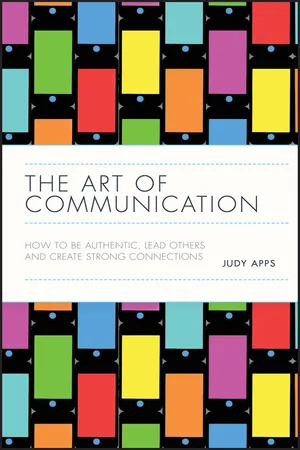
The Art of Communication
How to be Authentic, Lead Others, and Create Strong Connections
- English
- ePUB (mobile friendly)
- Available on iOS & Android
About this book
Bring nuance, depth, and meaning to every conversation you have
The Art of Communication is for anyone who senses that they could be communicating on a deeper level. Perhaps you are a confident communicator but suspect there may be more to the art of conversation that you have not yet been able to access. Or perhaps you feel that your conversations lack depth and meaning and that you'd like to enrich your relationships with others, if only you knew how. This book will address your concerns and show you how to engage wholeheartedly with others.
There's more to conversation than just clear, rational thinking. Left-brain rationality is important, of course, but neuroscience increasingly shows that the right-brain skills of creativity, intuition and spontaneity are essential in good communication. In this guide, you'll discover ways of tapping into the full conversational potential that lies dormant within you, adding a level of nuance and watching the result as your relationships blossom. You may even find that untapped value in the form of new insights, ideas and creative thoughts, emerges from your daily conversations.
- Access the more nuanced arts of conversation to create strong connections and tangible results
- Build cross-disciplinary, cross-cultural connections to communicate effectively with people from different backgrounds
- Activate your whole mind — not just your intellect — to bring creativity and depth to communication
- Learn to be open-hearted, spontaneous, vulnerable, intuitive, and captivating in every conversation you hold
From communication guru and bestselling author Judy Apps, The Art of Communication will show you how to breathe life into your relationships and produce powerful new thinking enabling you to transform the world you live in.
Frequently asked questions
- Essential is ideal for learners and professionals who enjoy exploring a wide range of subjects. Access the Essential Library with 800,000+ trusted titles and best-sellers across business, personal growth, and the humanities. Includes unlimited reading time and Standard Read Aloud voice.
- Complete: Perfect for advanced learners and researchers needing full, unrestricted access. Unlock 1.4M+ books across hundreds of subjects, including academic and specialized titles. The Complete Plan also includes advanced features like Premium Read Aloud and Research Assistant.
Please note we cannot support devices running on iOS 13 and Android 7 or earlier. Learn more about using the app.
Information
Part One
Introduction: Amazing Conversations
Some conversations give you a buzz of connection that surprises and delights. In such conversations time stands still and the boundaries between you collapse, allowing something new and exciting to emerge. But how can you encourage such connections to happen more often when conversation is by its nature spontaneous and unpredictable?
Prologue: Just Another Conversation
What Is the Art of Communication?
Frisson of Connection

- Remember a time when you had a conversation that felt especially enjoyable or remarkable. Maybe it felt more real, more three‐dimensional somehow, than normal encounters? Or maybe an ordinary conversation miraculously lifted off to another plane and it was as if a veil had lifted between you? You felt a thrill of pleasure like waves of energy running all over your skin and you felt intensely alive.
- Spend a moment or two remembering the occasion and capture the feeling you had at the time.
- Ask yourself, what gave you pleasure? What made it exceptional? Accept whatever answers pop up in your mind.
The Risks of Spontaneity
POPULARITY OF THE UNPREDICTABLE
Table of contents
- Cover
- Table of Contents
- Part One: Introduction: Amazing Conversations
- Part Two: Opting for Control
- Part Three: The Alternative World of Real Communication
- PEOPLE INDEX
- INDEX
- End User License Agreement